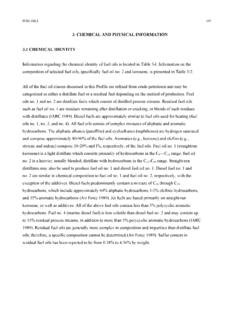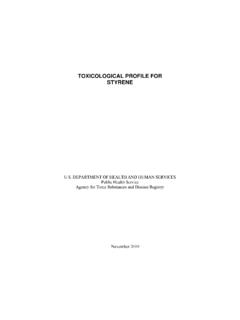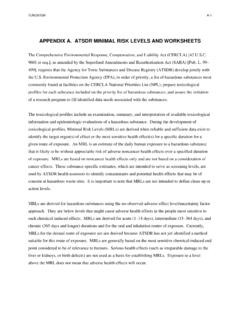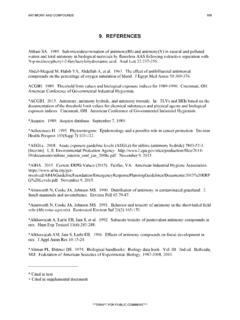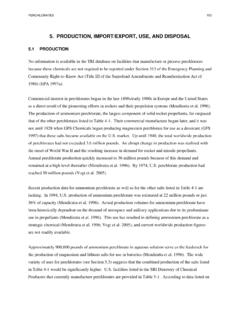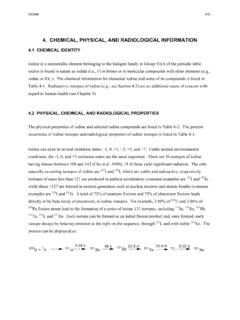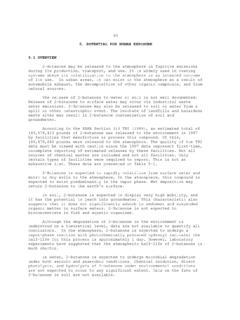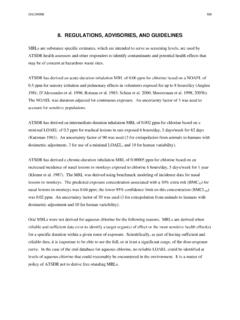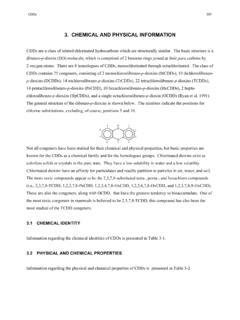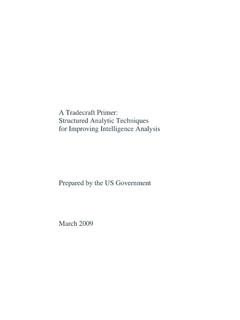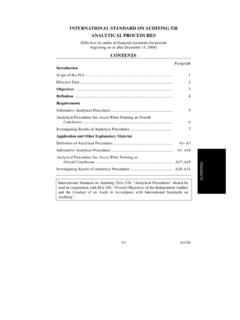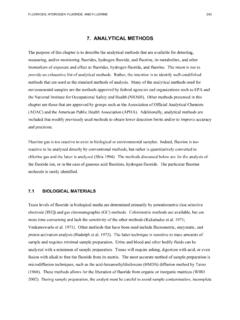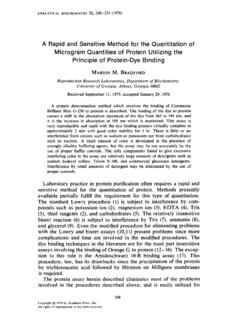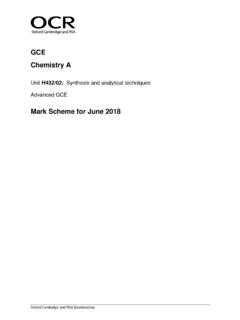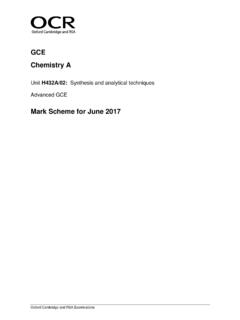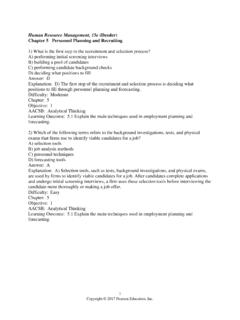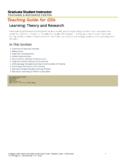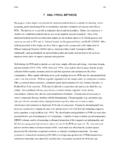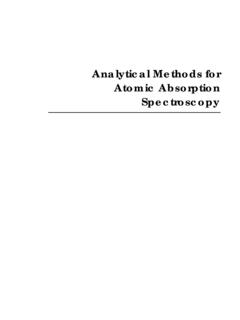Transcription of 7. ANALYTICAL METHODS
1 COBALT 265 7. ANALYTICAL METHODS The purpose of this chapter is to describe the ANALYTICAL METHODS that are available for detecting, measuring, and/or monitoring cobalt, its metabolites, and other biomarkers of exposure and effect to cobalt.
2 The intent is not to provide an exhaustive list of ANALYTICAL METHODS . Rather, the intention is to identify well-established METHODS that are used as the standard METHODS of analysis. Many of the ANALYTICAL METHODS used for environmental samples are the METHODS approved by federal agencies and organizations such as EPA and the National Institute for Occupational Safety and Health (NIOSH). Other METHODS presented in this chapter are those that are approved by groups such as the Association of Official ANALYTICAL Chemists (AOAC) and the American Public Health Association (APHA).
3 Additionally, ANALYTICAL METHODS are included that modify previously used METHODS to obtain lower detection limits and/or to improve accuracy and precision. BIOLOGICAL MATERIALS Entry of cobalt and its radioisotopes into the human body can be gained through ingestion, inhalation, or penetration through skin. The quantities of cobalt within the body can be assessed through the use of bioassays that are comprised of either in vivo and/or in vitro measurements. In vivo measurements can be obtained through techniques that directly quantitate internally deposited cobalt using, for example, whole body counters.
4 These in vivo measurement techniques are commonly used to measure body burdens of cobalt radioisotopes ( , 60Co), but cannot be used to assess the stable isotope of cobalt (59Co). Instead, in vitro measurements provide an estimate of internally deposited cobalt (both the stable and radioactive isotopes), utilizing techniques that measure cobalt in body fluids, feces, or other human samples. Examples of these ANALYTICAL techniques are given in NRCP Report No. 87 (1987) and are also listed in Tables 7-1 and 7-2. Internal Cobalt Measurements In vivo measurement techniques are the most direct and widely used approach for assessing the burden of cobalt radioisotopes within the body.
5 The in vivo measurement of these radioisotopes within the body is COBALT 266 7. ANALYTICAL METHODS Table 7-1. ANALYTICAL METHODS for Determining Stable Cobalt in Biological Materials Sample ANALYTICAL Sample Percent matrix Preparation method method detection limit recovery Reference Urine Direct injection Addition of magnesium nitrate and nitric acid matrix modifiers and equal volume dilution of sample with water Sample chelated with dithiocarbamic acid derivative, solvent extracted Sample wet digested with acid and chelated with 2.
6 3 butanedion dioxide and complex preconcentrated at hanging mercury drop electrode Direct injection Whole Sample diluted with a blood homogenizer Sample wet digested with acid and chelated with 2,3-butanedion dioxine and complex preconcentrated at hanging mercury drop electrode Sample acid digested, complexed with thiocyanate and N-phenylcinnamo hydroxamic acid and ex tracted into ethyl acetate Serum Direct injection GF-AAS with Zeeman back ground correction GF-AAS with Zeeman back ground correction GF-AAS with Zeeman back ground correction DPCSV GF-AAS with Zeeman back ground correction GF-AAS with D2 background correction DPCSV Colorimetric GF-AA with Zeeman back ground correction g/L g/L g/L g/L g/L 2 g/L g/L mg/L g/L 101% at Bouman et al.
7 40 g/L 1986 at Kimberly et al. 50 g/L 1987 No data Alexandersson 1988; Ichikawa et al. 1985 No data Heinrick and Angerer 1984 No data Sunderman et al. 1989 No data Heinrick and Angerer 1984 No data Heinrich and Angerer 1984No data Afeworki and Chandravanshi 1987 No data Sunderman et al. 1989 COBALT 267 7.
8 ANALYTICAL METHODS Table 7-1. ANALYTICAL METHODS for Determining Stable Cobalt in Biological Materials Sample ANALYTICAL Sample Percent matrix Preparation method method detection limit recovery Reference Blood or Acid digestion ICP-AES (NIOSH 10 g/g 81% at NIOSH 1984 tissue method 8005) (blood); 110 g/L g/g (blood) (tissue) D2 = deuterium; DPCSV = differential pulse cathodic stripping voltammetry; GF-AAS = graphite furnace atomic absorption spectrometry; ICP-AES = inductively coupled plasma-atomic emission spectrometry; NIOSH = National Institute for Occupational Safety and Health COBALT 268 7.
9 ANALYTICAL METHODS Table 7-2. ANALYTICAL METHODS for Determining Radioactive Cobalt in Biological Samples Sample matrix Preparation method ANALYTICAL method Sample detection limita Percent recovery Reference Urine Direct count of sample -spectrometry with NaI detector No data (<MDL) No data Miltenberger et al. 1981 Soft tissue Sample wet-ashed -spectrometry (NaI) No data No data Baratta et al. 1969 Sample directly counted in detector -spectrometry 5 pCi/g No data Rabon and Johnson 1973 Sample digested in acid, oxidized with HClO4, con centrated by precipitation with AMP, purified by resin column, precipitated with hexachloroplatinic acid -counter pCi/g 40 85% Nevissi 1992 Feces Direct count of sample -spectrometry No data No data Smith et al.
10 1972 Blood Red cells separated from plasma and washed -spectrometry with NaI detector No data No data Smith et al. 1972 a1 Bq= Ci=27 pCi AMP = ammonium molybdophosphate; MDL = minimum detectable level; NaI = sodium iodide COBALT 269 7.
